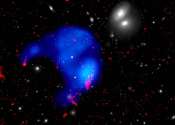Study solves mysteries of Voyager 1's journey into interstellar space
In a study published today in the Astrophysical Journal Letters, scientists from the University of New Hampshire and colleagues answer the question of why NASA's Voyager 1, when it became the first probe to enter interstellar ...









